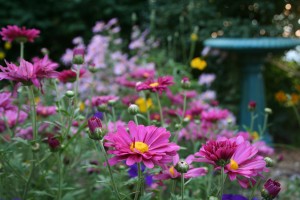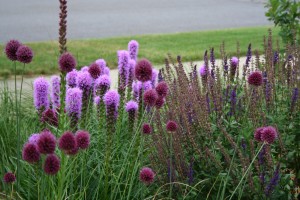Who Needs a Haircut?
 By midsummer, the plants – like some of the kids – are looking scruffy. It’s time for haircuts! Many perennials and annuals benefit from trimming back or selective pruning in midsummer. Reasons for doing the pruning vary as does the severity of the haircut.
By midsummer, the plants – like some of the kids – are looking scruffy. It’s time for haircuts! Many perennials and annuals benefit from trimming back or selective pruning in midsummer. Reasons for doing the pruning vary as does the severity of the haircut.
Whenever you prune, make sure your scissors, hand shearers or bypass pruners are clean to avoid spreading diseases from plant to plant.
Cutting back after flowering. For perennials that bloom early in the season a serious snipping back after first flowering will make the plant look neater and may encourage a second round of blooms. Perennial geraniums, catmints (Nepeta), coreopsis, pinks, wild sweet William, bearded iris, and spotted deadnettle are among the plants that benefit from being cut back to about half of their size after flowering. This keeps plants upright, rather than sprawling in the garden. Some flowering shrubs, such as spirea, also can be cut back to remove dead flowers and encourage another round of blooming.
Annual pruning. While you are cutting back your mounded perennials, take a look at the annuals in your beds and containers. If you see lone flowers coming off of long stems, it’s time for cutting back. Many annuals are refreshed by a midsummer trim and will look nice well into fall. If you have not been doing it regularly, now is also a good time to give annuals in pots some fertilizer.
 Cutting back before blooming. Mums are the most common plant needing this kind of trimming. Most people recommend not pinching (cutting back) mums after July 4, but if your mum is a late fall bloomer, you can pinch it back into mid-July. The idea behind pinching mums is to create a bushier plant as the mum puts out more shoots in response to pinching. Bushier plants equal more flowers and a more rounded shape.
Cutting back before blooming. Mums are the most common plant needing this kind of trimming. Most people recommend not pinching (cutting back) mums after July 4, but if your mum is a late fall bloomer, you can pinch it back into mid-July. The idea behind pinching mums is to create a bushier plant as the mum puts out more shoots in response to pinching. Bushier plants equal more flowers and a more rounded shape.
Deadheading. Think of this as a contemplative task that needs to be done every few days. Just take a walk around the garden, pruner in hand, and remove the blooms that look dead and scraggly. It’s probably the easiest way to improve the appearance of your garden, though the arrival of more and more “self-cleaning” plants may indicate it is not a favorite task of gardeners. Another reason to deadhead regularly: It prevents plants from setting seeds, which may be unwanted plants in your garden next year.
